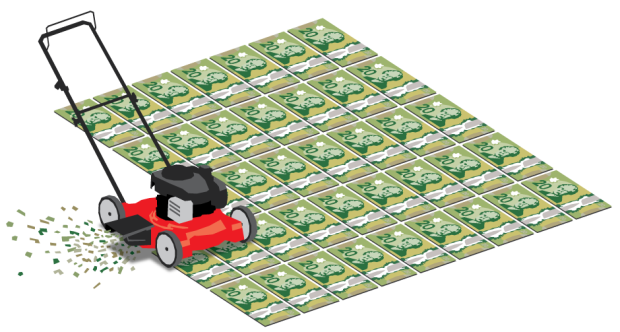Business
Summertime and the Living is Expensive: Six warm-weather Spending Traps, and How to Avoid Falling in

Summer isn’t for saving; it’s the season for spending. At least, that’s the message that many Canadians relay when banks trot out their annual spending surveys.
This year, more than half of Canadians surveyed for a Bank of Montreal poll admitted that their summer habits have negative long-term effects on their savings. One quarter say they spend themselves into debt, another 27 per cent dip into savings and 13 per cent forego saving and debt repayment to have fun. Millennials, according to a Tangerine survey, were more likely than other groups to overspend on food and beverage (63 per cent) and outdoor activities (43 per cent) this summer.
“People have a lot of pent up socializing to do. We hunker down in the winter and when summer comes, we’ll drive miles, we’ll make lots of food,” says Gail Vaz-Oxlade, author of Money Talks. “(People splurge on) the bicycles and the barbecues and the outdoor patio furniture because people are desperate to get out and enjoy the summer. They have a devil-may-care attitude about what they’re spending to have a good summer. (They) think, ‘I’ll go buy myself a canoe.’”
Whether you’re spending on canoes, landscaping or vacations, here are some of the common spending traps summer sets for us — and how to mitigate them.
Yard maintenance If you do your own landscaping and lawn care, you’re going to save money. That being said, if you absolutely do not want to cut your own grass or ruin your shoes by aerating the lawn with your high heels, consider hiring a neighbourhood teen.
In an effort to save, my husband and I tried to DIY our own landscaping. But after a few seasons, my front yard, as my husband would tell you, “is bringing down the neighbourhood.” To destroy our weed jungle, dig up two dead trees and some bushes, transplant shrubbery and spread mulch, the quotes began at $1,000.
We decided to use money we had set aside for new patio furniture to clear the yard; planting new greenery and flowers will have to wait until next year. Thinking about your yard as an ongoing project — and thus, ongoing expense — will help you control how much it costs.
“To me, the garden is a work in process. I will decide what I will do now and what I am prepared to wait to do,” says Vaz-Oxlade who devotes $100 a month in her budget to her garden and spends the $1,200 in the spring. “I have a girlfriend who likes things to be finished. She comes into my garden and says, ‘Doesn’t that drive you crazy?’ I say, ‘No, because I can see what it is going to be.’”
Big stuff for your big summer fun Seasonal items such as patio furniture will go on sale later in the summer; however, your choices will be limited by what is left in stock. If you’re looking for bigger ticket items such as water skis or furniture, consider buying it used. This past week, someone just sold a fantastic glass patio table, umbrella and six plush chairs for $190 on my local Bidding Wars Facebook group. If you don’t immediately find what you’re looking for online, set up a Kijiji alert for the item. And don’t forget to comb the house for things that you can sell yourself to recoup some cash.
Summer camp for kids “Camp is not cheap. It’s more expensive than daycare,” says Lee Helkie, a certified financial planner and partner of Helkie Financial. “My kids are seven and 10. My daughter’s overnight camp is a riding camp for $1,200 a week. My son is going to a golf camp that’s $400 and a sports camp that’s $375 a week.”
First, determine how much you can spend to send kids to camp. Then decide, with your kids, where and how to divide that sum. (Don’t forget to budget for extra gear, etc. that you may need for the camp.) “Set the amount with them and talk to them about what they want to do,” Helkie says. “I’m a big believer in, as your kids get older, helping them to understand that (money) doesn’t grow on trees.”
To save you money, some camps offer a siblings discount, so consider sending your kids to the same camp. Also, many have early-bird or return-camper discounts. If you can’t afford the entire cost up-front, ask if the camp has a payment plan. Some camps have subsidy programs with financial applications due earlier in the year.
Don’t forget to keep your receipts for tax time; if the activities are eligible, you can claim on your 2016 return up to $500 for the children’s fitness tax credit and up to $250 for the children’s arts tax credit.
Finally, in lieu of pricey summer camps, look for free or low-cost programs run by your local library, community centre or religious organization.
Vacations The key to saving money on vacations is planning, Helkie says. Search for resorts or hotels or restaurants that offer free promotions for kids. Do a Google search for Groupon deals or coupon codes for local attractions. Consider visiting hot spots such as Arizona or Florida, which can be cheaper in the summer months, or explore your own country. Opt for a road trip and find accommodations with a kitchen through Airbnb, VRBO or Homeaway.com.
“It’s the last-minute kind of stuff that ends up getting you into trouble,” Helkie says. “Get the kids involved in research. Especially as your kids get older, make it a family event. Get them to look at all of the sites.”
Staycations People think that by doing a staycation, they won’t be spending money. You need to have a budget for this as well. Keep a calendar of events that you want to enjoy with the family and the associated costs. “It’s a consciousness about what you’re doing with your money,” Vaz-Oxlade says. “If you have a sense or a plan, you’re far less likely to go wrong. Know what you plan to spend on.”
Making memories with your people Barbecues, concerts, weddings — the events add up, but making lasting memories doesn’t have to mean creating lasting debt. It’s about making choices: saying “no” to something so you can say “yes” to something else, Helkie says.
Also, it’s never too late to start saving for your good times. It could be as simple as putting aside every $5 bill you see in your wallet for patio drinks. Even better, set up an automatic transfer of cash every payday for your summer expenditures.
“Your mortgage doesn’t go down in the summer just because it’s nice out,” Helkie says. “You still have to be mindful of what you have, what’s coming in and what’s going out. And it’s way more fun to spend money you have.”
Business
Beauty Week is back at Hudson’s Bay in Toronto and it’s time to get glam

Beauty enthusiasts rejoice! Beauty Week at Hudson’s Bay is back in Toronto for another year. It’s time to stock up on all of your fall essentials and, maybe discover some new ones.
From Friday, August 18 to Sunday, August 27, you can expect a truly elevated beauty experience in-store with incredible special offers, limited-time gifts, and exciting activations.
If you’re a diehard beauty lover, you’ll already know that Hudson’s Bay is the place to shop thanks to its extensive range of over 195 skin and makeup brands from both luxury labels and masstige brands — including Tata Harper, Estée Lauder, YSL, Nars Cosmetics, Bobbi Brown, and so much more.
Throughout The Bay’s Beauty Week, visitors can take in some at-counter activations and interactive expert-led tutorials, where there will be chances to get makeup touch-ups from top-tier brands, try a spritz of the most alluring fragrances, and sample tons of new products.
This year’s Beauty Week highlight is the ‘Best in Beauty’ tote, a meticulously-curated selection of 30 deluxe samples from an array of top-tier brands like Dr. Barbara Sturm and Shiseido spanning skincare, fragrance, and makeup — all in a super sleek bag.
The tote, which is valued at over $300, is retailing for just $39 and is a fantastic way to explore new products (without breaking the bank). However, there is a limited quantity, so if you want to get your hands on one, you’ll need to be fast.
Wondering exactly what Beauty Week’s free gifts with purchases entail? If you spend over $95 at Lancôme, you will receive a six-piece set valued at $130. Or, you can get an Estée Lauder gift valued at $170 with purchases over $80. (And that’s just to name a few.)
If you’re a Hudson’s Bay Rewards member, you’ll also get $20 in Hudson’s Bay rewards when you spend over $100 on beauty.

Business
The Canadian Armed Forces are hiring for several non-combat military jobs

The Canadian Armed Forces (CAF) have several non-combat jobs, some of which do not require a college degree or past work experience.
Life in the forces has several benefits, such as paid education plans (college, university and graduate-level programs), 20 paid vacation days, health and dental coverage for you and your family, maternity and paternal leave, and pension plans. You can learn more about the benefits in detail here.
And to make it easier to gauge if you qualify, the listings also include related civilian jobs to see if it’s your ideal role.
Financial services administrator
Related civilian jobs: Financial records entry clerk, financial manager, accounting technician, bookkeeper, budget officer, cashier clerk, business planner technician, and verification manager.
Description: You’ll help budget resources for all military activities besides providing financial assistance.
Education: You need to have completed Grade 10.
Duties: As a financial services administrator, you’ll be responsible for bookkeeping and managing budgets. You’ll also provide support in accounts payable and accounts receivable.
Work environment: Those in this role work at CAF bases, on ships or overseas. You might also be expected to help special operation units, recruiting offices, schools, and medical organizations.
Postal clerk
Related civilian jobs: Mail clerk, mail sorter.
Description: You’ll provide postal services to members and their families at bases and establishments.
Education: Grade 10. No previous work experience or related career skills are required.
Duties: As the postal clerk, you’ll handle mail duties.
Work environment: Besides a postal office, you may work on a ship or a mobile postal van. You might be expected to serve with Royal Canadian Navy, the Army, and the Royal Canadian Air Force in Canada and abroad.
Dental technician
Related civilian jobs: Dental assistant, dental hygienist.
Description: You’ll be helping dental officers provide dental services to CAF members, their families, and dependents.
Education: Level II dental assisting diploma from an accredited college or a National Dental Assisting Examining Board (NDAEB) certificate.
Duties: Those in this role will be responsible for various responsibilities, including disinfection and sterilization of dental equipment, applying rubber dams, placing cavity liners, and controlling bleeding. In addition, you’ll assist in laboratory procedures like creating casts, custom trays, and mouthguards.
Work environment: This role will require you to work in a military dental clinic, a Mobile Dental Clinic, an Air Transportable Dental System, or onboard a ship. You might be expected to work on a base in Canada or other operations in other parts of the world.
Human resources administrator
Related civilian jobs: Records administrator, data entry supervisor, receptionist, office manager, executive assistant, payroll clerk, and information management technician.
Description: Provide administrative and general human resources support.
Education: Grade 10. No previous work experience or related career skills are required.
Duties: In addition to human resources administration and services, you’ll be handling pay and allowances, managing automated pay systems, and maintaining personnel records.
Work environment: HR administrators work at all CAF bases in Canada. They also work on ships and overseas to support the Canadian Army, Royal Canadian Navy, or Royal Canadian Air Force operations.
Medical assistant
Related civilian jobs: Emergency medical responder, ambulance and first aid attendant, registered nursing assistant, licensed practical nurse, and hospital orderly.
Description: Successful candidates will help treat the sick and injured in CAF units. You’ll be assisting and supporting nursing and medical officers.
Education: Minimum of Grade 11 biology, Grade 10 physics or chemistry, and Grade 10 math.
Duties: You’ll provide initial care and essential life support treatments in trauma cases. You’ll help with health assessments (hearing and vision tests, perform basic lab procedures, etc.) and initiate and manage medical records and reports. You’ll also be expected to provide support and first aid during training exercises.
Work environment: Medical assistants may serve with the Royal Canadian Navy, the Royal Canadian Air Force or the Canadian Army as part of the Canadian Forces Health Services Group. Those in this role are exposed to the same risks as the forces they support.

Business
Porter’s new loyalty program promises to match Air Canada’s Aeroplan status

Porter Airlines is once again stirring the pot among Canadian airline rivals, now going after Air Canada’s Aeroplan members by offering to match their loyalty status to an equivalent of their own.
The beloved airline, which recently ranked as having the best cabin service in North America, challenged the competition for the second time this year, after previously deploying a similar tactic against WestJet in the spring.
Earlier in April, Porter presented customers with a limited-time offer to match the loyalty status of WestJet’s patrons with VIPorter levels.
Now, they’re offering Aeroplan members to seamlessly transition to an equivalent VIPorter Avid Traveller status based on their existing membership tier.
Members can then take advantage of an array of travel perks that come with flying Porter, including seat selection, baggage, and flight changes.
For those currently holding an Aeroplan membership, there are two ways to acquire the Avid Traveller status for the rest of 2023:
Status-Based Match:
- Aeroplan 25K members = VIPorter Venture
- Aeroplan 35K members = VIPorter Ascent
- Aeroplan 50K, 75K, and Super Elite = VIPorter First
Flight Segments-Based Match:
- 5 flight segments = VIPorter Passport
- 8 segments = VIPorter Venture
- 17 segments = VIPorter Ascent
- 28 or more segments = VIPorter First
Members will have to first submit their applications on Porter’s website. Registration will remain open until September 6, 2023.
In order to maintain their membership level through 2024, customers will have until the end of 2023 to reach the following reduced qualifying spend (QS) targets:
- Passport = $500 in QS
- Venture = $750 in QS
- Ascent = $1500 in QS
- First = $2500 in QS
Over the past year, Porter has launched an aggressive expansion strategy, including everything from introducing longer flights on newly-purchased jet planes flying out of Toronto Pearson, free WiFi, and a new all-inclusive economy experience.
With Canadians losing both Swoop and Sunwing as WestJet incorporates both into their mainline business, Porter’s direct competition is welcome to keep prices competitive.

-

 Lifestyle9 months ago
Lifestyle9 months agoOntario Line subway construction permanently shuts down beloved Toronto bakery
-

 Business9 months ago
Business9 months agoThe Canadian Armed Forces are hiring for several non-combat military jobs
-

 Business9 months ago
Business9 months agoPorter’s new loyalty program promises to match Air Canada’s Aeroplan status
-

 Lifestyle9 months ago
Lifestyle9 months agoWoman crashes car and runs around highway with bottle of booze on typical day in Toronto
-

 Business9 months ago
Business9 months ago‘Here, everything feels much closer’: Entrepreneur says leaving Toronto for Innisfil good for business
-

 Business9 months ago
Business9 months agoPeople call out Sobeys for ridiculous prices after another expensive find at Ontario store
-

 Lifestyle9 months ago
Lifestyle9 months agoCanada considers capping international student visas to address housing crisis
-

 Business9 months ago
Business9 months agoBeauty Week is back at Hudson’s Bay in Toronto and it’s time to get glam



